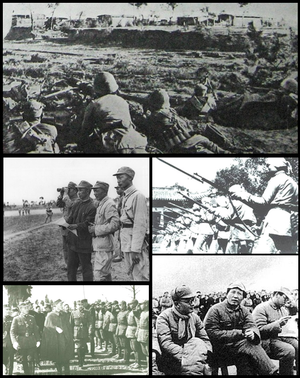Chinese civil war
| Chinese Civil War 國共內戰 (Kuomintang-Communist Civil War) |
|||||||
|---|---|---|---|---|---|---|---|
 Clockwise from the top: Communist troops at the Battle of Siping, Muslim soldiers of the NRA, Mao Zedong in the 1930s, Chiang Kai-shek inspecting soldiers, CPC general Su Yu investigating the front field shortly before the Menglianggu Campaign |
|||||||
|
|||||||
| Belligerents | |||||||
|
1927–36; 1946–47
Supported by: |
1927–36
Supported by: |
||||||
|
1947–49
Supported by: |
1946–49
Supported by: |
||||||
1949–50
Supported by: |
1949–50
Supported by: |
||||||
| Commanders and leaders | |||||||
| Strength | |||||||
|
|
||||||
| Casualties and losses | |||||||
| c. 1.5 million (1948–49) | c. 250,000 (1948–49) | ||||||
|
|||||||
| Chinese Civil War | |||||||||||||||||||
| Traditional Chinese | |||||||||||||||||||
|---|---|---|---|---|---|---|---|---|---|---|---|---|---|---|---|---|---|---|---|
| Simplified Chinese | |||||||||||||||||||
| Literal meaning | Kuomintang-Communist Civil War | ||||||||||||||||||
|
|||||||||||||||||||
| War of Liberation (mainland China) | |||||||||||||||||||
| Traditional Chinese | |||||||||||||||||||
| Simplified Chinese | |||||||||||||||||||
|
|||||||||||||||||||
| Anti-Communist Counter-insurgency War (Taiwan) | |||||||||||||||||||
| Traditional Chinese | |||||||||||||||||||
| Simplified Chinese | |||||||||||||||||||
|
|||||||||||||||||||
| Chinese People's Liberation War (mainland China) | |||||||||||||||||||
| Traditional Chinese | |||||||||||||||||||
| Simplified Chinese | |||||||||||||||||||
|
|||||||||||||||||||
| Third Internal Revolutionary War (mainland China) | |||||||||||||||||||
| Traditional Chinese | |||||||||||||||||||
| Simplified Chinese | |||||||||||||||||||
|
|||||||||||||||||||
| Transcriptions | |
|---|---|
| Standard Mandarin | |
| Hanyu Pinyin | Guó-Gòng Nèizhàn |
| Wu | |
| Romanization | gho-gon-ne-tsan |
| Yue: Cantonese | |
| Jyutping | gwok3 gung6 noi6 zin3 |
| Southern Min | |
| Hokkien POJ | kok-kiōng lāi-chiàn |
| Transcriptions | |
|---|---|
| Standard Mandarin | |
| Hanyu Pinyin | Jiěfàng Zhànzhēng |
| Wu | |
| Romanization | chia-fhon-tsan-zen |
| Yue: Cantonese | |
| Jyutping | gaai2 fong3 zin3 zang1 |
| Southern Min | |
| Hokkien POJ | kái-hòng chiàn-cheng |
| Transcriptions | |
|---|---|
| Standard Mandarin | |
| Hanyu Pinyin | Fǎngòng Kānluàn Zhànzhēng |
| Transcriptions | |
|---|---|
| Standard Mandarin | |
| Hanyu Pinyin | Zhōngguó Rénmín Jiěfàng Zhànzhēng |
| Transcriptions | |
|---|---|
| Standard Mandarin | |
| Hanyu Pinyin | Dìsāncì Guónèi Gémìng Zhànzhēng |
Chinese Communist victory
The Chinese Civil War was a civil war in China fought between forces loyal to the Kuomintang (KMT)-led government of the Republic of China, and forces loyal to the Communist Party of China (CPC). The war began in August 1927, with Generalissimo Chiang Kai-shek's Northern Expedition, and essentially ended when major hostilities ceased in 1950. It can generally be divided into two stages; the first being from 1927 to 1937, and the second being from 1946 to 1950 with the Second Sino-Japanese War separating them. The war was a major turning point in modern Chinese history, with the CPC gaining control of almost the entire of Mainland China, establishing the People's Republic of China (PRC) to replace the KMT's Republic of China (ROC). It also caused a lasting political and military standoff between the two sides of the Taiwan Strait, with the ROC in Taiwan and the PRC in mainland China both officially claiming to be the legitimate government of all of China.
The war represented an ideological split between the Communist CPC and the KMT's brand of Nationalism. It continued intermittently until late 1937, when the two parties came together to form the Second United Front to counter the Japanese threat and prevent the country from crumbling. China's full-scale civil war resumed in 1946, a year after the end of hostilities with Japan. Four years later came the cessation of major military hostilities, with the newly founded People's Republic of China controlling mainland China (including Hainan) and the Republic of China's jurisdiction being restricted to Taiwan, Penghu, Quemoy, Matsu and several outlying islands.
...
Wikipedia
